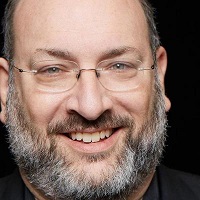 By David Harlow, JD MPH, Principal, The Harlow Group LLC
By David Harlow, JD MPH, Principal, The Harlow Group LLC
Twitter: @healthblawg
Host: Harlow on Healthcare
Hashtag: #HarlowOnHC
Rasu Shrestha is the Chief Innovation Officer of the University of Pittsburgh Medical Center and also serves as an Executive Vice President of UPMC Enterprises. You should follow him on Twitter: @RasuShrestha. We spoke about the meaning of innovation and about some of the innovations — past, present and future — at UPMC.
Rasu describes his north star as the best interests of the person — the consumer, the health plan member, the patient — and he sees that as being distinct from the notion of being patient-centered. Innovation, for UPMC, boils down to doing whatever is in the best interest of the person, deploying resources and building institutional culture to serve the best interests of the person.
UPMC has long been out in front in the realm of clinical innovation (consider the Starzl Institute, and its namesake’s pioneering work in liver transplantation), and it is now also focused on combining clinical excellence with analytical excellence. Rasu chose as one example a company spun out of UPMC, in a partnership with the Advisory Board: Evolent Health. The tools at the core of the company were developed by the UPMC health plan to better manage risk and, as Rasu says, the hunch that there was a market for these tools, packaged with advisory services, turned out to be correct; at the time of its IPO a couple of years a go, the company was valued at over $1 billion. Other examples: Curavi Health – telemedicine for long term care and other postacute care settings, and Lantern Health – making behavioral health tools more readily available that can reduce stigma and improve access to expertise.
More broadly, we spoke about the need to move from a focus on data and to a focus on information, and knowledge, enabling communication with patients or members through a variety of channels, to enable behavior change. As Rasu said, even though UPMC is building three new hospitals, there will be no net increase in the number of inpatient beds. Keeping people out of the hospital, nudging them towards healthier behaviors, will ultimately be better than providing more inpatient care at hospitals. The challenge is to operate a hospital where “heads and beds” are not the key metric of success. The goal is to manage illness and sustain patients in “the circle of wellness.”
Rasu’s vision of the future has technology becoming invisible. Artificial intelligence, machine learning, interoperability, all need to be harnessed more effectively to augment who we are as human beings, to eliminate the impediments to care that technology currently represent (e.g., 40% of physician-patient encounter spent with physician’s back to the patient while focused on the EHR screen). We need to leverage technology to give us better insights while also letting technology do the mundane work of integrating multiple data streams that need to be reviewed and analyzed.
Technology can help enable communication, connection, collaboration, empathy — we need to use technology in the best interests of the patient.
This article was originally published on HealthBlawg and is republished here with permission.
